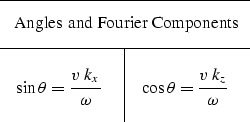One of the main ideas in Fourier analysis is that an impulse function (a delta function) can be constructed by the superposition of sinusoids (or complex exponentials). In the study of time series this construction is used for the impulse response of a filter. In the study of functions of space, it is used to make a physical point source that can manufacture the downgoing waves that initialize the reflection seismic experiment. Likewise observed upcoming waves can be Fourier transformed over t and x.
Recall that a plane wave carrying
an arbitrary waveform is given by
equation (4).
Specializing the arbitrary function to be
the real part of the function ![]() gives
gives
| |
(14) |
Using Fourier integrals on time functions we encounter the
Fourier kernel
![]() .To use Fourier integrals on the
space-axis x the spatial angular frequency must be defined.
Since we will ultimately encounter many space axes
(three for shot, three for geophone, also the midpoint and offset),
the convention will be to use a
subscript on the letter k to denote the
axis being Fourier transformed.
So kx is the angular spatial frequency on
the x-axis and
.To use Fourier integrals on the
space-axis x the spatial angular frequency must be defined.
Since we will ultimately encounter many space axes
(three for shot, three for geophone, also the midpoint and offset),
the convention will be to use a
subscript on the letter k to denote the
axis being Fourier transformed.
So kx is the angular spatial frequency on
the x-axis and ![]() is
its Fourier kernel.
For each axis and Fourier kernel there is the question of the
sign before the i.
The sign convention used here is the one used in most physics books,
namely, the one that agrees with equation (14).
With this convention, a wave moves in the
positive
direction along the space axes.
Thus the Fourier kernel for (x , z , t)-space
will be taken to be
is
its Fourier kernel.
For each axis and Fourier kernel there is the question of the
sign before the i.
The sign convention used here is the one used in most physics books,
namely, the one that agrees with equation (14).
With this convention, a wave moves in the
positive
direction along the space axes.
Thus the Fourier kernel for (x , z , t)-space
will be taken to be
| |
(15) |
Now for the whistles, bells, and trumpets. Equating (14) to the real part of (15), physical angles and velocity are related to Fourier components. The Fourier kernel has the form of a plane wave. These relations should be memorized!
 |
(16) |
A point in ![]() -space is a plane wave.
The one-dimensional Fourier kernel extracts frequencies.
The multi-dimensional Fourier kernel extracts (monochromatic) plane waves.
-space is a plane wave.
The one-dimensional Fourier kernel extracts frequencies.
The multi-dimensional Fourier kernel extracts (monochromatic) plane waves.
Equally important is what comes next.
Insert the angle definitions into the familiar
relation ![]() .This gives a most important relationship:
.This gives a most important relationship:
| |
(17) |
Equation (17) also achieves fame as the ``dispersion relation of the scalar wave equation,'' a topic developed more fully in IEI.